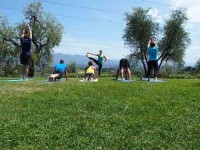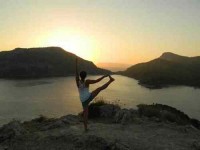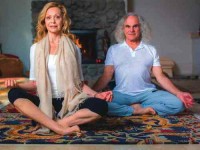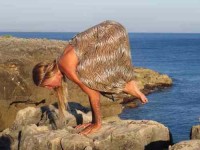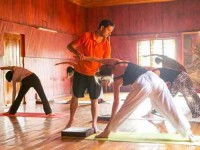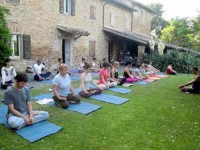All yoga retreats
Styles of Yoga
Amrit - This style of Yoga is sometimes called “meditation in motion” and was developed by Yogi Amrit Desai (the founder of Kripalu Yoga). There are 3 stages in this style of Yoga, the first of which consist of a physically active routine of 26 postures. Stages 2 and 3 are focused on developing an intuitive, meditative flow through the postures, all the while releasing inner tensions and cultivating at a deep, heart-centered state of peaceful integration.
Anahata – Developed by Ana Costa and is referred to as “meditative interpretation of Hatha Yoga” and is very heart centered. It focuses on correcting bad posture and opening the heart chakra.
Ananda - These classes are comprised of gentle postures, which focus on breath and alignment, to prepare the body for meditation.
Anusara – Founded by John Friend, this style of Yoga is based upon Hatha Yoga. Each class has a heart-oriented theme and the movements are linked with the breath.
Ashtanga – Pattabhi Jois is credited with designing this demanding, athletic style of Yoga, which synchronizes breathing with progressively more demanded postures. This is a very popular form of Yoga in the US and is sometimes called Power Yoga.
Bhakti - “Bhakti” is Sanskrit for “devotion” so this is “Yoga of Devotion” or “Yoga of Universal Love” and it is one of the four traditional types or branches of Yoga. (The others are Jnana – the Path of Wisdom, Karma – the Yoga of Selfless Service, and Raja – from the Sanskrit root yuj, which means to yoke or unite, this is Yoga to unite us with the Divine or the Self)
Bikram – This is usually called Hot Yoga and was founded by Bikram Choudhury, a 1963 gold medal Olympic weight lifter. These strenuous postures are performed in a room that is heated to 95-105 degrees.
Classical - This is seen more as an approach to yoga that honors the traditional spiritual goals of Yoga, more than it being an actual set of specific practices Dru – Soft, flowing movements coupled with breath control and visualizations. This is also a heart-centered practice.
Flow - Flow Yoga classes may be in seen on the schedule of many studios. This is not really a classical style of practice, but the term is often used to mean a Vinyasa style of class, where postures and breath are linked.
Forrest – Created by Ana Forrest, this program is designed to help you connect to your core and awaken your senses through heat, deep breathing, and holding vigorous postures.
Gitananda – Created by Swami Gitananda Giri Gurumaharaj and sometimes referred to as Rishiculture Ashtanga Yoga, it is a practice of combining traditional spiritual sciences with the modern science of allopathic medicine to create a practice of Jnana, Raja and Hatha Yoga.
Hatha – Refers to the postures or asanas of Yoga, but someone who teaches a Hatha Yoga class may also incorporate Pranayama (breath work), Meditation and the other limbs of Yoga in their teachings. There are many styles of Yoga that may fall into the Hatha Yoga category. For example, if you train with YogaFit, you learn a specific style of Hatha Yoga that is a Vinyasa flow. Hot Yoga – Bikram Yoga is often called Hot Yoga, which was founded by Bikram Choudhury, a 1963 gold medal Olympic weight lifter. These strenuous postures are performed in a room that is heated to 95-105 degrees.
Integral – A traditional style of yoga that combines asanas, Pranayama, service to others, chanting and meditation. One of the main aims of Integral yoga is to discover your true self.
Ishta – Created by Alan Finger and his father, Kavi Yogi Sivananda Mani Finger, this style of yoga is a physical and spiritual form that addresses the needs of each individual student, blending asanas, breathing and mental focus. The postures range from slow movements to more vigorous, sweat-inducing postures. ISHTA stands for Integrated Science of Hatha, Tantra and Ayurveda.
Ivamukti – This form of Yoga was created in 1984 by David Life and Sharon Grannon. It emphasizes vigorous postures performed as a vinyasa flow, but also incorporates visualization, chanting and meditations. This is popular among many Hollywood celebrities.
Iyengar – A very popular form of Yoga that is alignment based. It was developed by B.K.S. Iyengar. In my opinion, this is a great way to learn about the correct alignment of postures and to sharpen your ability to stay with a posture and maintain your focus.
Japa - A form of Yoga where a mantra is repeated with the goal of mental purification
Jnana - One of the four traditional types or branches of Yoga. In this style of Yoga, the objective is to develop the mind and discover the truth behind life experiences. The practice includes meditation and kriyas.
Jivamukti - Created in 1984 by David Life and Sharon Gannon, the word “Jiva” in Sanskrit refers to the “individual soul” and “Mukti” refers to “freedom” or “liberation”. This style of yoga incorporates a challenging vinyasa style asana practice, meditations, visualizations, chanting, music, and specific class themes.
Karma – One of the four traditional types or branches of Yoga that is seen in a selfless approach to life, where what one does is for the benefit of others and not for personal gain.
Kriya – Yoga of Purification. These re cleansing practices and are thought to have an impact on both the physical and energetic planes of the body and includes purifying the nadis (subtle energy channels) and raising the life force energy with practices such as Breath of Fire (Kapalabhati).
Kundalini – Yoga that works to raise the powerful energy that resides at the base of the spine and direct it upward. This practice incorporates Pranayamas, Dharana and Dhyana.
Laya – This style of Yoga falls within the Tantra school of Yoga, and is called the Yoga of Absorption and helps practitioners get through difficult times and overcome negativity. It is focused on listening to nada, or internal sounds. Other tools used are mantras, yantras (geometric design used as a tool for contemplation), mudras and intense meditations.
Mudra – The Sanskrit word “mudra” comes from the root word “mud” which means “to commune” or “bring together” and refers to joining the Lower Self with the Higher Self. The word “mudra” itself is actually translated as “gesture” or “seal”. These are typically hand gestures or specific hand positions, such as Namaste hands. This is not really a style of Yoga so much as a practice utilized in other Yoga traditions, especially Tantric and Hatha Yoga practices.
Raja – One of the four traditional types or branches of Yoga, Raja Yoga is named from the Sanskrit root yuj, which means to yoke or unite, this is Yoga to unite us with the Divine or the Self. This Yoga practice takes students through various levels of physical, mental and psychic exercises to prepare them for the state of Self-Awareness.
Svaroopa – This therapeutic style means “true nature” or “bliss” in Sanskrit. The poses focus on releasing muscular tension, especially around the spine. A release called a “core opening” is at the center of Svaroopa philosophy, where the student is encouraged to release muscle tension from the tailbone to the crown of the head, which practitioners believe leads to personal transformation and healing.
Tantra – This style of Yoga is sometimes misunderstood and feared. However, in its true practice, it is based on the principle of polar energies (similar to yin and yang) and deals with the left-hand path (exoteric) and the right-hand path (esoteric). Awakening of the Kundalini energy is employed in Tantra practices with the goal of leading to higher states of awareness.
Yantra - This is sometimes called the “geometric path to oneness” and deals with sacred geometry wherein rupas (geometric form that serves as a meditation device, such as a mandala) are used to unlock latent energies go gain powerful knowledge. Complex meditations which explore numbers, names, forms and their relationships are part of Yantra Yoga.
Yin - Yin Yoga is comprised of gentle stretches that release the connective tissues and puts slight pressure on the joints. The muscles are relaxed while performing the poses, and the postures are held from 2 minutes to 10 minutes.
- Anusara Yoga
- Aqua yoga
- Ashtanga Yoga
- Ayurveda Yoga
- Bhakti Yoga
- Bihar Yoga
- Bikram / Hot Yoga
- Dynamic Yoga
- Hatha Yoga
- Himalayan yoga
- Hridaya yoga
- Integral yoga
- Iyengar Yoga
- Jivamukti Yoga
- Kripalu Yoga
- Kriya Yoga
- Kundalini Yoga
- NEW INDIA
- Nidra Yoga
- Power Yoga
- Restorative Yoga
- Sivananda Yoga
- Tantra Yoga
- Taoist yoga
- Vinyasa Yoga
- Yin Yoga
- Yoga flow
- All yoga retreats
- DESTINATION: India +
- Costa Rica
- Greece
- Indonesia
- Italy
- Mexico
- Morocco
- Portugal
- Spain
- Thailand
- Turkey
- USA



